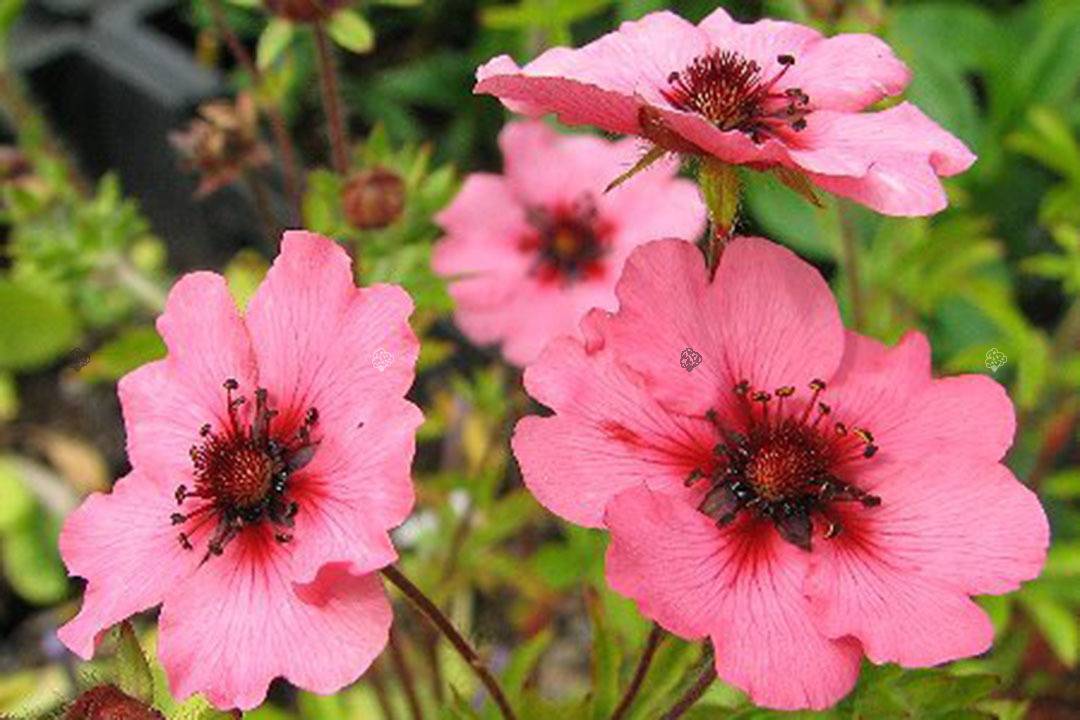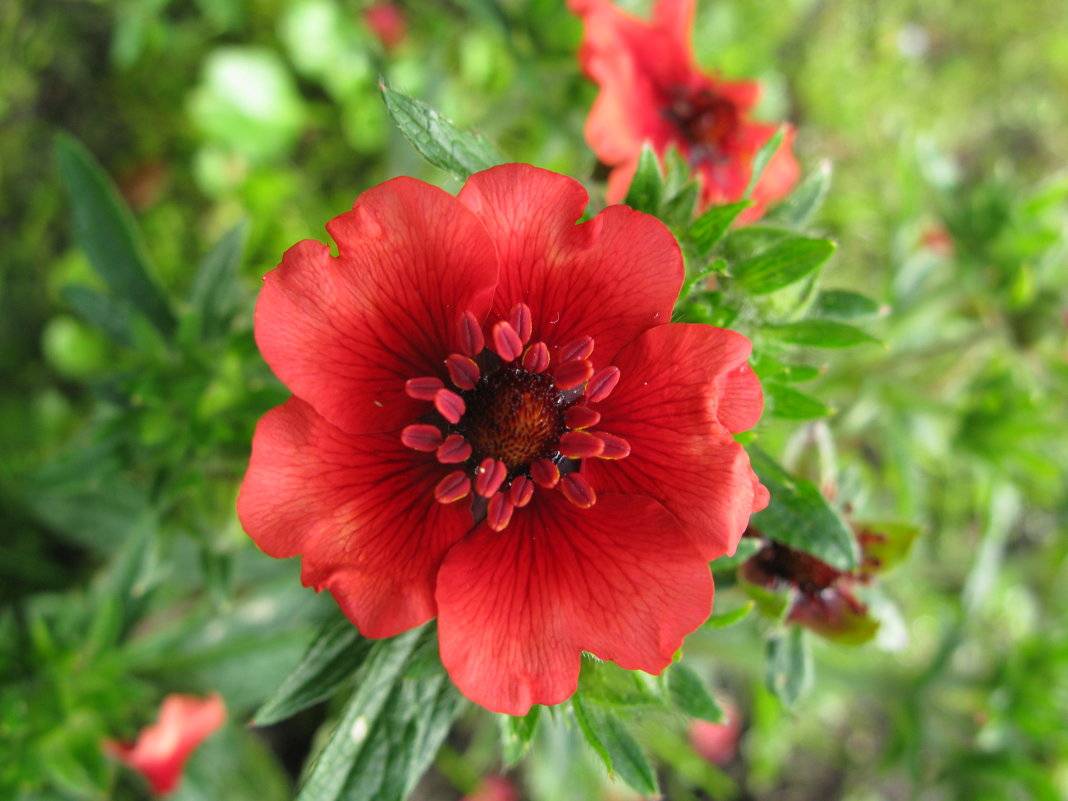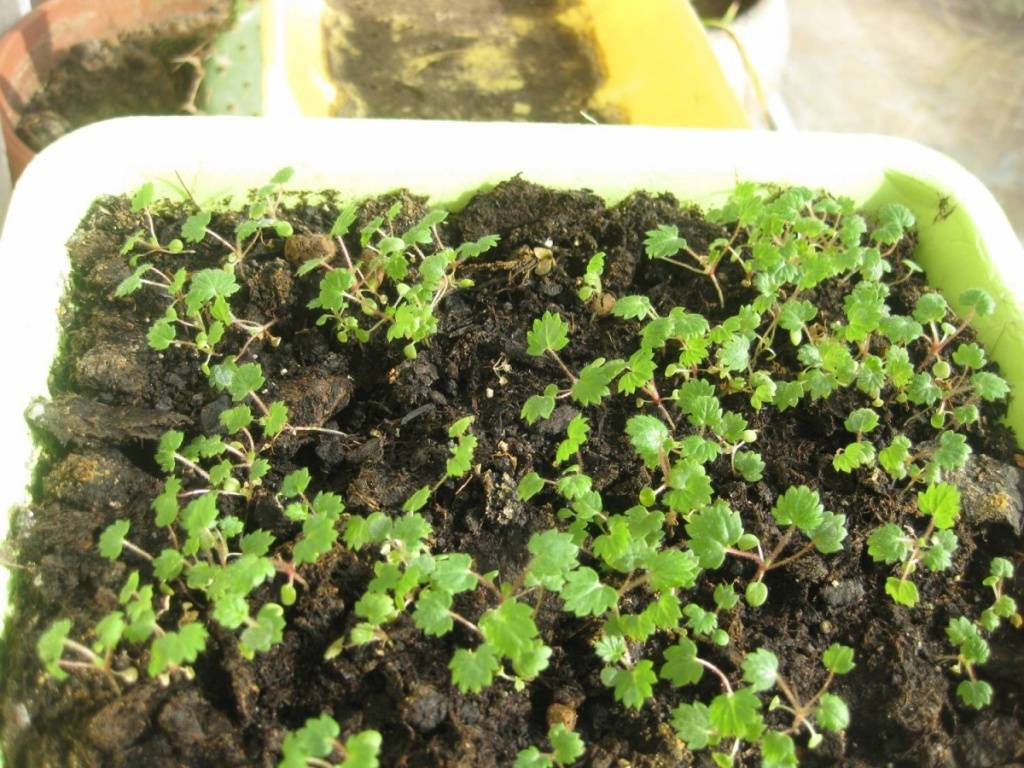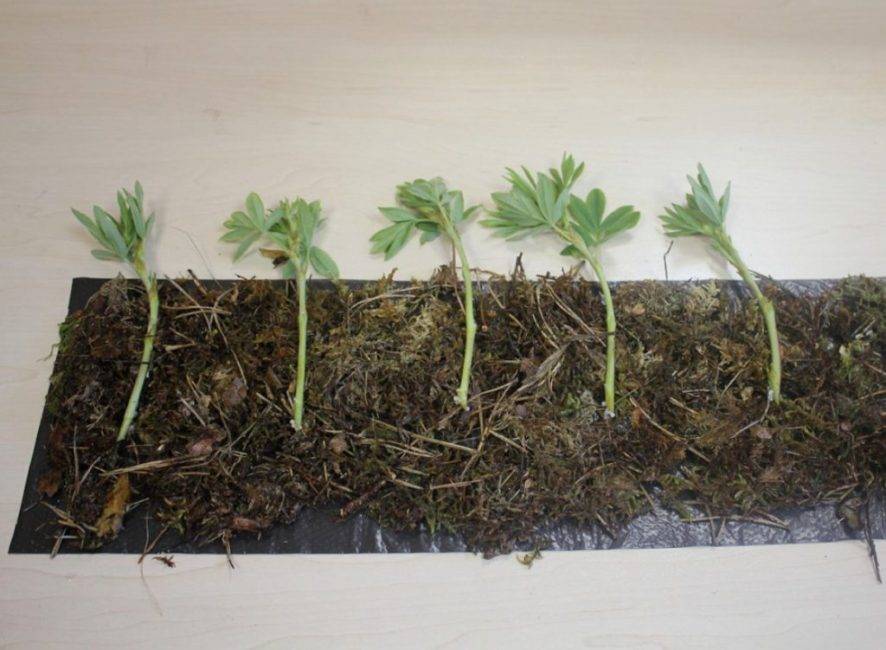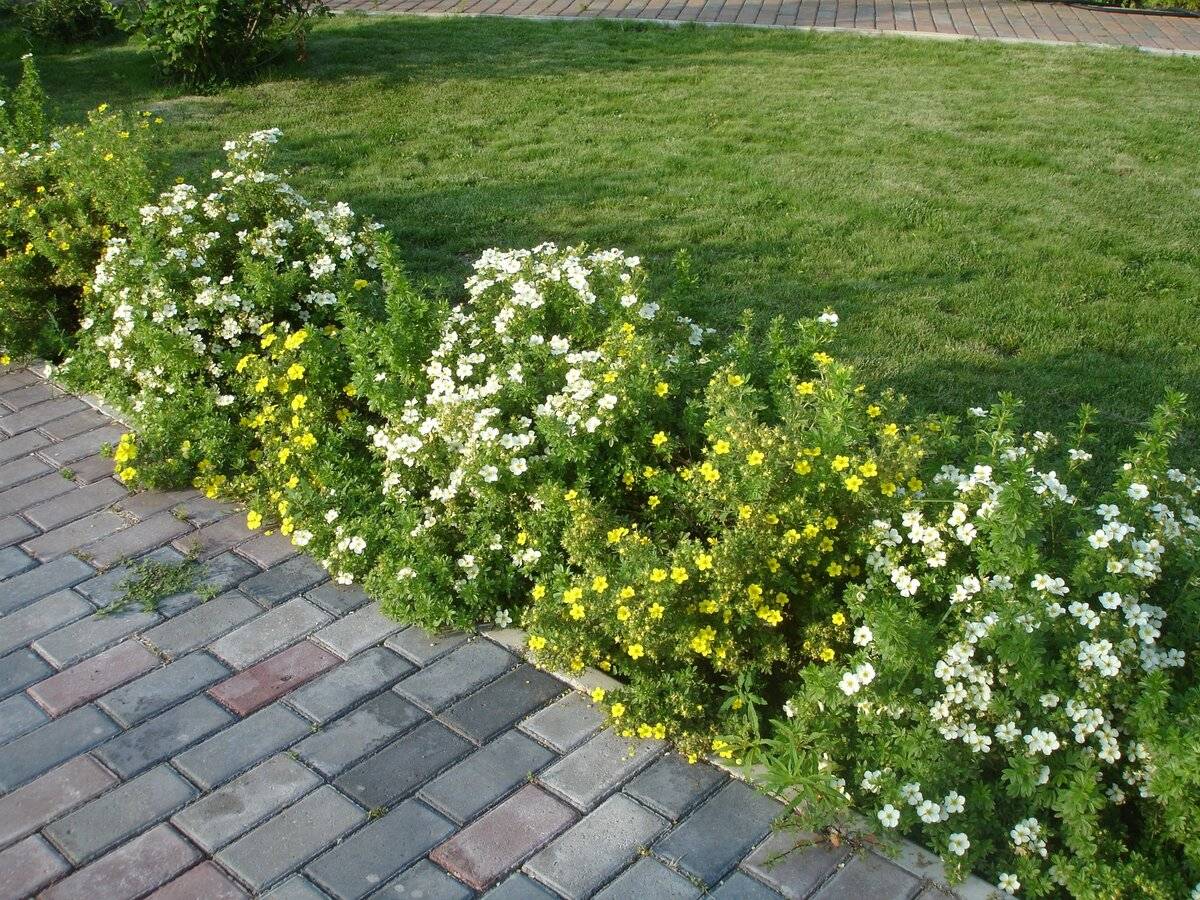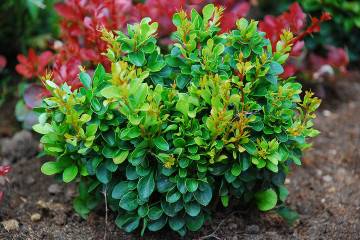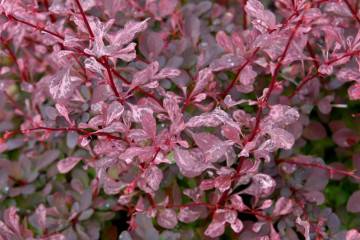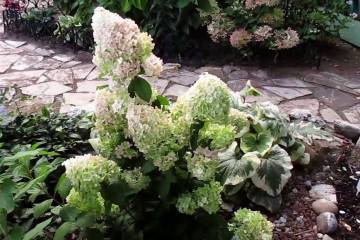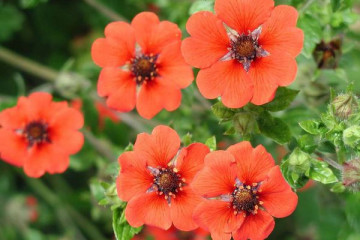Nepalese cinquefoil - description, varieties, care
Content:
One of the most beautiful varieties of perennial culture is Nepalese Potentilla. Large elegant inflorescences, unpretentiousness in cultivation and care, vitality to the harsh climate - qualities for which many gardeners like to plant a plant in their summer cottage.
Description of Nepalese Potentilla
An ornamental plant represents the Pink family. It has many different forms:
- herbaceous perennials and annuals;
- shrubs, semi-shrubs.
Nepalese cinquefoil is native to the high Himalayas, Nepal, as indicated by the name of the flower.
Description of culture:
- the height of the plant is no more than half a meter. Red stems branch magnificently;
- green (pale and bright) leaves are spreading, finger-shaped (length up to 35 cm). The color of the leaf plate depends on the quality of the soil;
- pale pink flowers with a bright (darker) middle. In the inflorescence there are usually 5 petals, there are 4, but rarely. Each petal grows as if by itself.
Popular varieties
The culture is ancient, known from the 18th century. Since then, new varieties and hybrids of the plant have been bred, numerous varieties have appeared. They differ in the time and duration of flowering, the color of the petals, but the care of the crop remains the same.
Miss Willmott's cinquefoil is the most famous variety. Bright cherry-colored inflorescences with a dark center. The variety is viable for both frosty winters and insect pests. Nepalese Potentilla Miss Wilmont blooms long and profusely with elegant pink flowers.
An equally popular variety is Legend Potentilla. She has pale pink petals with a maroon eye in the middle. Growing this variety in the country is no more difficult than other varieties.
The amazing color of the petals of the Fiery Flame flowers is a dark crimson middle on a pale pink background. Shrub no more than 45 cm high, blooms from July to September.
The name of the variety Flower Carpet speaks for itself. Blooms from June to late September. The only condition for abundant and lush flowering is sufficient sunlight.
Planting a plant
You can plant Nepalese Potentilla at any time: from early spring to autumn, when it is warm. When planting, it is important to consider the basic requirements:
- the presence of the sun;
- lack of close occurrence of groundwater.
Planting from seeds
Growing a plant is not at all difficult, since the culture is unpretentious to growing conditions: soil, place.
The seeds are harvested on their own or purchased from a store. Germination is maintained for at least 2 years. The seed material is small, so the planting is carried out superficially. Spread into slightly damp soil and cover with a thin layer of earth or sand.
Seeds are sown 2–2.5 months before planting in open ground.
Next steps:
- When grown at home, the sown seeds are covered with plastic wrap or glass to retain moisture and warmth. Seedlings will sprout in 2 weeks.
- Containers with sprouts are removed in a cool room (no more than 18 ° C), watered after 2 days.
- After 1.5–2 months, the seedlings dive. Since the roots are very small, you need to do everything carefully so as not to damage them.
Planting seedlings in open ground
When the warm weather is firmly established, the seedlings are transplanted to the site:
- Choose a sunny place where water does not stagnate. Nepalese cinquefoil and clematis are good neighbors. Nepalese bushes protect capricious vines from the hot sunlight.
- They are planted in holes, maintaining a distance of at least 30 cm.
Cinquefoil is planted at any convenient time: from May to September.
How to care for Nepalese cinquefoil
Plant care is the same as for other horticultural crops: watering, feeding, loosening, weeding.
Undemanding Potentilla grows in any conditions. But in order for the beauty and power of culture to be fully manifested, it is advisable to take a little care of the plant.
Watering
In cool climates with enough rain, the Nepalese culture is not watered at all. In prolonged dry weather, the plant is watered at least 2 times in 7 days (10 liters of water are consumed per 1 m²).
Water the culture without fanaticism, since stagnant water at the roots will lead to decay.
Top dressing
For full-fledged growth and development of cinquefoil, 3-time organic feeding is suitable:
- peat;
- manure;
- humus.
Sometimes they are fed along with mineral additives, for example, ash.
It is advisable to make top dressing at certain times:
- for the first time immediately after the snow melts;
- in late spring (in May), when the buds are forming in the plant;
- when flowering ends (end of August, September).
In addition to top dressing, caring gardeners remove weeds and loosen them. This work can be replaced by laying mulch at the roots of the plant. Mulching inhibits the growth of weeds, retains moisture, due to which the amount of watering is reduced.
Reproduction methods
There are several breeding options for Nepalese Potentilla:
- layering. Choose an escape, make an incision. They are bent to the ground, pinned. The place of the incision is sprinkled with a layer of earth. With the appearance of the roots, they are transplanted to the right place;
- cuttings. First, the flowers are removed, cuttings no more than 11 cm long are cut. They are dropped into a container, taken home or covered with a mini-greenhouse (glass cut with a plastic bottle) in the garden in the garden. When new buds are formed, they are cut off so as not to weaken the cutting. Roots will grow in 50-60 days;
- dividing the bush. The bush is dug up, the root is cleaned. Using a sharp knife, the rhizome is divided into several parts, leaving at least 3 buds on each. They are planted in separate holes, the interval between which is 25–35 cm;
- seeds. Sometimes they sow right away on the site.
Potentilla is propagated by dividing the bush or by cuttings after 4 years of growing the plant, until the root system gets stronger.
Even an inexperienced florist can handle any of the methods.
Transfer
The plant is transplanted in any warm weather (summer or autumn):
- Carefully, trying not to damage the roots of Potentilla, they dig out the bush.
- The plant is lowered into a prepared hole, the size of which is no less than an earthen coma on a bush and a depth of 55-60 cm.
- Fall asleep with earth, lightly tamping. Watering. Pour mulch. The interval between the planting pits must be maintained at 35–40 cm.
They take care of the plant in the same way as in the old place.
Diseases and pests
Like any other flower culture, Potentilla is plagued by diseases.
More often the plant has:
- rust;
- powdery mildew;
- spotting.
Bordeaux liquid, fungicidal preparations are used by gardeners to prevent and treat diseases of Nepalese Potentilla.
The peculiar smell of the plant repels most harmful insects.Only the scoop attracts. They are treated with insecticides: decis, phytoverm, fufanol. The main thing is to follow the instructions on the manufacturer's packaging.
Flowering period
The beginning and duration of Potentilla flowering largely depends on the variety.
Plant varieties delight the eye with white flowers in the spring-summer period (May-June). Blooming with pink, orange, yellow flowers continues until autumn frosts.
Preparing for winter
Nepalese cinquefoil and other varieties are loved by flower growers for their vitality. Plants not only bloom until frost, but are also not afraid of the cold Russian winter. The culture is resistant to a sharp change in temperature.
If the frosts are strong, the temperature drops below -26 ° C, it is better to cover the plants. This can be done with spruce paws or with a thick layer of mulch.
Use in landscape design
Bright elegant flowers of Nepalese Potentilla will decorate a garden, a summer cottage, and an adjoining territory. Often grown for the purpose of creating landscape design. The plant looks especially festive among undersized crops.
From the bushes of the Nepalese Potentilla, they arrange a live multi-colored hedge, and also frame the flower beds. When creating landscape compositions, they are planted both separately and in groups.
Beneficial features
The healing properties of Nepalese Potentilla have long been known. There are especially many useful substances in the roots of the plant. With the help of Potentilla decoctions, wounds were treated, anesthetized, and inflammation was treated.
The plant helps with many diseases:
- thyroid gland;
- goiter;
- hormonal disruption;
- metabolic disorders.
Cinquefoil weakens attention, concentration, it tends to sleep. These cultural traits are not suitable for drivers or those with mindfulness work.
Nepalese cinquefoil is an amazing perennial plant. It is unpretentious, frost-resistant, rarely gets sick, blooms for a long time. Crop care is minimal. It is a pleasure to grow such flowers.
